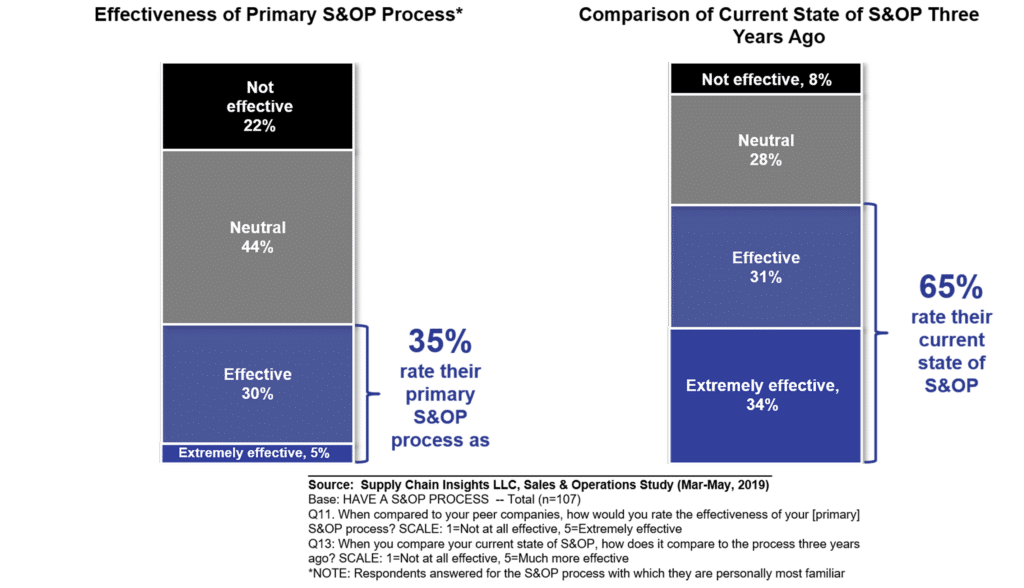
What is integrated business planning (IBP)? Is it identical to sales and operations Planning (S&OP), an extension of it, or something altogether separate? A GPS for your business? That sounds more like a slogan than a practical definition.
Call it what you want, IBP is probably best thought of as mature S&OP. It has overcome an early identity crisis and proved itself as a powerful enterprise planning tool, helping companies meld financial, sales, production, procurement and marketing information into a single plan, grounded in reality.
What Does IBP offer?
Integrated business planning is a new level of visualizing, evaluating and optimizing your supply chain. It distills complex, cumbersome and disconnected tasks into a single integrated process that streamlines and unites planning activities to produce better business decisions. Combining data from across the enterprise, IBP creates one planning framework by removing organizational and technology barriers and synchronizing plans across strategic and tactical time horizons.
So What’s the Problem?
How can something so potentially valuable be so difficult to achieve? Is there really a problem? Based on recent work with clients, Lora Cecere, founder and CEO of Supply Chain Insights, produced research that clearly demonstrates the decline in perceived S&OP effectiveness.

Given that IBP is an advanced, well-developed state of S&OP, it follows that companies struggling with S&OP may consider IBP a bridge too far. At least temporarily. Unfortunately, some will simply stop trying. Even those organizations that have successful S&OP efforts under way are challenged by the stamina needed to continue the journey to fully-fledged IBP.
Why Integrated Business Planning Initiatives Fail
There are myriad reasons why integrated business planning initiatives fail, but we’ll focus on those we hear most often.
1) No Executive Engagement
How many times have you read that? It seems trite now, but one of the fundamental reasons why integrated business planning initiatives fail through lack of executive leadership is because:
- IBP done right is going to require hard decisions about risk mitigation and margins, for example, that leadership can’t delegate and can’t dodge;
- When it gets difficult — and it will — you’ll need to rely on the power of the hierarchy to move forward.
2) Poor or Non-Existent Data Governance
CIO Magazine says data governance is a system for defining who within an organization has authority and control over data assets and how those data assets may be used.
IBP will expose data silos and data turf wars, as well as multiple definitions for seemingly straightforward concepts like “forecast” and “demand.” Be prepared to work hard developing a single source of truth. Turning a world of data into a data-driven world depends on many things, including firm definitions and roles.
3) No Clear Goals
Lora Cecere reminds us that IBP is actually the third step of maturity in an S&OP implementation. Each stage has a different goal. Over 95% of companies she consults with jump into planning without answering these three questions:
- What is the goal of your S&OP process?
- How do you make decisions?
- What do you measure?
Each phase builds on what comes before. Usually, after failing, companies find that they must first be able to execute “what if” analyses to determine a feasible plan before attempting to match demand with supply. And that mastering the process of matching demand with supply is a prerequisite to successful IBP.
4) No Cross-Functional Collaboration, Lack of Focus on Data Model and Analytical Plan
These might seem like strange topics to combine. The whole point of IBP is aligning the organization in a forward trajectory, and that’s hard to do without the involvement of all the key stakeholders.
Inability to translate among different functional views of information can be alienating, especially in the early stages when buy-in might be fragile. Sales inputs revenues by account, Operations may want to see demand in units by product, and Finance is interested in margin. Ideally, the same information should be tailored to stakeholders in a manner they understand.
5) IBP Gets Positioned as an IT Project
IBP can’t be viewed as a module that your ERP provider can license to you or a new report that IT could write for you if they had time. It must be positioned and even revered as radical, transformative, permanent, and worth the effort.
6) The Role of the Budget is Undefined
Many industry experts believe the key change management issue for IBP is wrangling the role of the budget. Some companies treat the budget as sacrosanct. As a result, they constrain the outcome of IBP to ensure that budget goals are met.
Others realize that the quest to maximize enterprise opportunity while mitigating risks can mean that IBP outcomes drive budget updates.
7) Poor Setting of Expectations
Saving the most obvious for last, perhaps. Consider the following as you sharpen your diplomacy skills, preferably at the outset of your IBP project, not the middle:
- The entire contemplation is far-reaching and complex. Don’t strive for “one number” anything. Some companies spend months deriving a single “guiding” number that is so massaged and scrubbed that the only thing you can be sure of is its inaccuracy. Others paralyze themselves trying to evaluate hundreds of metrics. Pick your big 12 and start. Monitor them and learn from them.
- Most IBP projects eventually uncover incentives at cross purposes. It could be Sales and quota credit versus Operations and customer satisfaction. Persevere! (And remember what we said about executive engagement.)
- You are on a journey. There is no IBP finish line. But there are exciting milestones offering better business outcomes.
Outcomes Worth the Effort
Understanding why integrated business planning initiatives fail is the first step towards success. The reality of IBP is that the effort spans multiple departments, people, timeframes and often continents. The path is not always pretty. But the rewards are dramatic: processes that balance resources and information with corporate objectives to increase revenues, reduce costs and boost profitability. Imagine understanding strategic trade-offs years in advance while making the day-to-day decisions based on the real-time pulse of your business. Top floor and shop floor in sync. But there are pitfalls. We hope the guidance above helps you avoid some of them.



